Pas de biographie disponible.
Compositeur Musique additionelle Librettiste Parolier Metteur en scène Chorégraphe Producteur création Producteur version

Musical
Musique: Andrew Lloyd Webber • Paroles: Tim Rice • Livret: Production originale: 24 versions mentionnées
Dispo: Résumé Synopsis Génèse Liste chansons
Genèse: Joseph and the Amazing Technicolor Dreamcoat is an Andrew Lloyd Webber musical with lyrics by Tim Rice. The story is based on the "coat of many colors" story of Joseph from the Bible's Book of Genesis. This was the first Lloyd Webber and Rice musical to be performed publicly. (Their first musical, The Likes of Us, written in 1965, was not performed until 2005.) Joseph was first presented as a 15-minute pop cantata at Colet Court School in London in 1968 and was recorded as a concept album in 1969. After the success of the next Lloyd Webber and Rice piece, Jesus Christ Superstar, Joseph received stage productions beginning in 1970 and expanded recordings in 1971 and 1972. While still undergoing various transformations and expansions, the musical was produced in the West End in 1973, and in its full format was recorded in 1974 and opened on Broadway in 1982. Several major revivals and a 1999 straight-to-video film, starring Donny Osmond, followed. The show has little spoken dialogue; it is completely sung-through. Its family-friendly storyline, universal themes and catchy music have resulted in numerous productions of Joseph and the Amazing Technicolor Dreamcoat; according to the Really Useful Group, by 2008 more than 20,000 schools and amateur theatre groups had successfully put on productions. Lloyd Webber's composer father, William, felt the show had the seeds of greatness. He encouraged and arranged for a second performance — at his church, Westminster Central Hall — with a revised and expanded format. The boys of Colet Court sang at this performance in May 1968, which also included the Mixed Bag. It received positive reviews: London's Sunday Times said it was a new pop oratorio. By its third performance at St Paul's Cathedral in November 1968, it had been expanded to 35 minutes and included songs such as "Potiphar". Novello agreed to publish the work, and Decca Records recorded it in 1969 as a concept album. David Daltrey, front man of British psychedelic band Tales of Justine, played the role of Joseph; and Tim Rice was Pharaoh. Other vocalists included Terry Saunders and Malcolm Parry of the Mixed Bag. In 1970, Lloyd Webber and Rice used the popularity of their second rock opera, Jesus Christ Superstar, to promote Joseph, which was advertised in America as a "follow-up" to Superstar. Riding on Jesus' coattails proved profitable for Joseph, as the U.S. Decca recording of Superstar had been in the top of America's charts for three months. The first American production of Joseph was in May 1970, at Cathedral College of the Immaculate Conception in Douglaston, New York. Following this, according to Lloyd Webber's Really Useful site, "there followed huge interest from colleges and schools." A recording of the musical, with 12 tracks, was issued in the U.S. on Scepter Records in 1971. It featured David Daltrey as Joseph, Tim Rice as Pharaoh, Andrew Lloyd Webber on the organ, Alan Doggett conducting, various solo vocalists and instrumentalists, and the Colet Court choir as the chorus. In late August and September 1972, Joseph was presented at the Edinburgh International Festival by the Young Vic Theatre Company, directed by Frank Dunlop. It starred Gary Bond in the title role, Peter Reeves as the narrator, and Gordon Waller as Pharaoh. In October the production played at London's Young Vic Theatre, and in November at the Roundhouse. The production was part of a double bill called Bible One: Two Looks at the Book of Genesis. Part I, entitled The Genesis Mediaeval Mystery Plays: The Creation to Jacob (at the Young Vic originally called simply Mediaeval Mystery Plays), was Dunlop's reworking of the first six of the medieval Wakefield Mystery Plays, with music by Alan Doggett. Part II was Joseph and the Amazing Technicolor Dreamcoat. The Young Vic production was recorded for an LP released on the RSO label in 1972. This production was also televised in the UK by Granada Television in 1972. In February 1973, theatre producer Michael White and impresario Robert Stigwood mounted the Young Vic production at the Albery Theatre in the West End, where it ran for 243 performances. The mystery plays which had preceded the original Young Vic productions were dropped, and instead the musical was preceded by a piece called Jacob's Journey, with music and lyrics by Lloyd Webber and Rice and a book by television comedy writers Ray Galton and Alan Simpson. The new opening piece, Jacob's Journey, which contained a great deal of spoken dialogue, was eventually phased out in favour of a completely sung-through score. The first production of the show in its modern, final form was at the Haymarket Theatre in Leicester, which presented the musical several times in the mid- to late-1970s. A recording of the full musical was released on the MCA label in 1974, again featuring Gary Bond, Peter Reeves, and Gordon Waller. This is the earliest recording of Joseph to eventually go to CD. Gordon Waller also appeared on another recording in 1979, featuring Tim Rice as the Narrator and Paul Jones as Joseph, on the Music For Pleasure label. In 1975 Miranda Enterprises in association with Leicester Theatre Company presented a production of Joseph at the Queen's Theatre, Hornchurch. It was directed by Paul Tomlinson, Choreographed by David Thornton, and Designed by Hugh Durrant, with Chris Littlewood as the Musical Director. This production starred Patrick Ryecart as Joseph, David Sadgrove as Pharaoh, and had three Narrators: Nigel Baldwin, Ben Bazell, and Patrick Reilley. Ken Hill directed a large-scale production of Joseph at the Westminster Theatre, London, which ran from November 1978 to February 1979, and again from November 1979 to February 1980. This production starred Paul Jones as Joseph, John Golder as the Narrator, and Leonard Whiting as Pharaoh. The producer was Martin Gates, the Musical Director was Jack Forsyth, the Lighting Designer was Francis Reed, and the Designer was Saul Radomsky. With Jason Donovan in the lead, the expanded show was restaged in 1991 at the London Palladium with Steven Pimlott as director, winning the 1992 Laurence Olivier Award for set design. The cast album of this production was the #1 UK album for two weeks in September 1991, and the single "Any Dream Will Do" from it was also the #1 UK single for two weeks in June–July 1991. When Donovan left, former children's TV presenter Phillip Schofield portrayed Joseph.
Résumé: Jacob vit au pays de Canaan avec ses douze fils. Joseph, le cadet, est son enfant préféré. Jacob lui offre une superbe tunique de plusieurs couleurs, ce qui exacerbe la jalousie de ses autres fils. Joseph fait un rêve qui signifie qu’il connaîtra la réussite, contrairement à ses frères. Les frères de Joseph, exaspérés, décident de le jeter dans un puits. Ils vendent finalement Joseph comme esclave et le font passer pour mort auprès de Jacob en lui présentant la tunique de Joseph tâchée de sang (celui d’un animal, en réalité). Arrivé en Egypte, Joseph se retrouve injustement en prison, où il interprète avec succès les rêves d’autres prisonniers. Ses dons reconnus lui permettent d’approcher le Pharaon, qui est en proie à d’étranges rêves. Joseph lui explique que sept années de plein essor (symbolisées par sept vaches grasses) seront suivies de sept années de famine (représentées par sept vaches maigres). Grâce à ce présage, l’Egypte fait des réserves afin d’éviter la pénurie le moment venu et, en retour, Joseph connaît une belle ascension. Pendant la période de famine, les frères de Joseph viennent chercher de la nourriture en Egypte. Ils rencontrent Joseph, qui a atteint un rang élevé, sans le reconnaître. Joseph tente de savoir si ses frères ont changé. Il accuse son frère Benjamin d’être un voleur. Tous ses frères prennent sa défense. Conscient que ses frères sont devenus honnêtes, Joseph révèle sa véritable identité et peut retrouver sa famille à Canaan.
Création: 1/3/1968 - Colet Court School (Londres) - représ.
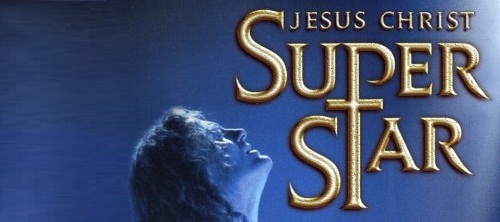
Musical
Musique: Andrew Lloyd Webber • Paroles: Tim Rice • Livret: Production originale: 26 versions mentionnées
1
Dispo: Résumé Commentaire
Genèse:
Résumé: Jesus Christ Superstar relate les sept derniers jours de Jésus, de l’entrée de Nazareth à la crucifixion, du point de vue du traître Judas Iscariote. Ce dernier n’arrive pas à comprendre le fanatisme et la confiance aveugle des disciples de Jésus. Il clame «C’est un homme, juste un homme ». C’est pourquoi il s’associe aux ennemis de Jésus. Il n’est que l’instrument de Dieu. Grâce à lui, à travers la destinée qu’il lui trace, Jésus va pouvoir devenir une «superstar». Ne maîtrisant plus la situation, il finira par se pendre, terrassé par ses remords.
Création: 12/10/1971 - Mark Hellinger Theatre (Broadway) - représ.

Musical
Musique: Andrew Lloyd Webber • Paroles: Tim Rice • Livret: Tim Rice • Production originale: 32 versions mentionnées
Dispo: Résumé Synopsis Commentaire Génèse Liste chansons
Vidéos:
Evita se concentre sur la vie de la leader politique argentine, Eva Perón, la seconde épouse du président (et dictateur) argentin Juan Perón. L'histoire suit Evita depuis sa jeunesse jusqu’à sa mort, en retraçant sa montée au pouvoir et son soutien aux œuvres de charité. Le musical est d’abord apparu sous la forme d’un album-concept d’opéra-rock, sorti en 1976. Son succès a permis la création de l’œuvre à la scène dans le West End de Londres en 1978 (au Prince Edward Theatre), remportant le Laurence Olivier Award pour la meilleure musique et fut créé à Broadway un an plus tard, où il a été la première comédie musicale Britannique à recevoir le Tony Award de la meilleure musique.
Genèse: In 1972, Robert Stigwood proposed that Andrew Lloyd Webber and Tim Rice develop a new musical version of Peter Pan, but they abandoned the project. The source material for the musical that made Rice intrigued about Eva Peron was a brief radio play he heard whilst driving his car, but more importantly the TV film Queen of Hearts by Argentine film director Carlos Pasini Hansen that Thames Television produced and had aired in the UK on the 24th of October 1972. Tim Rice had missed that showing but an executive of CIC (Cinema International Corporation) in London who was a mutual friend of Rice and Pasini introduced them and Pasini arranged for Tim to see the film at Thames Television which he did "at least twenty times" saying also that "by that time I had seen Pasini's superbly researched film, I was hooked." Rice then heard a radio play about Eva Duarte de Perón and approached Lloyd Webber with an idea for a musical collaboration based on her life. The more Rice investigated Eva Perón, going so far as to travel to Buenos Aires to research her life, with many documents and contacts that Pasini had supplied, the more fascinated he became by the woman; he even named his first daughter after her. The idea of writing a score including tangos, paso dobles, and similar Latin flavours intrigued Lloyd Webber, but he ultimately rejected the idea. Lloyd Webber decided instead to collaborate with Alan Ayckbourn on Jeeves, a traditional Rodgers and Hart-style musical based on the P.G. Wodehouse character, which proved to be a critical and commercial failure. Lloyd Webber returned to Rice, and they began developing Rice's proposed musical. The authors of the 1996 book Evita: The Real Life of Eva Perón claim that the musical was based on Mary Main's biography The Woman with the Whip, which was extremely critical of Eva Perón. Though Rice praised the Main biography, it was never officially credited as source material. Rice suggested that they create a character known as Che to serve as a narrator and Greek chorus. It was not his intention to base him on Che Guevara, but when Harold Prince later became involved with the project, he insisted that the actors portraying Che use Guevara as a role model. In the 1996 film adaptation, the character returned to his more anonymous roots. This was also the case for the 2006 London revival. As they previously had done with Superstar, the songwriting team decided to record Evita as an album musical and selected actress and singer Julie Covington to sing the title role. Released in 1976, the two-disc set included Paul Jones as Juan Perón, Colm Wilkinson as Che, Barbara Dickson as Perón's mistress, and Tony Christie as Agustín Magaldi. When the project began to take shape, Pasini wrote the dialogue in Spanish of the first scene of the musical "A Cinema in Buenos Aires" for the first recording of the album in which Julie Covington plays Eva. In this recording Pasini plays the part of the actor in the soundtrack of the "1952 movie that grinds to a halt" and also reads the official communique of Eva's death. In the brochure that accompanied the album that dialogue appears translated into English and the first "thanks" are to Carlos Pasini when the recording was first presented to the press in Andrew Lloyd Webber's country home. The visual presentation was organized by Pasini and his colleague Anton Furst using all the photographic material provided by Pasini. Lloyd Webber and conductor Anthony Bowles presented the musical at the second Sydmonton Festival before making the recording with the London Philharmonic Orchestra.[6] Prior to its release, they played it for Harold Prince and invited him to become involved with the eventual staging. Prince agreed, commenting, "Any opera that begins with a funeral can't be all bad", but he advised them that he could not take on any new commitments for the next two years.[7] In Britain, Australia, South Africa, South America, and various parts of Europe, sales of the concept album exceeded those of Jesus Christ Superstar; in the United States, however, it never achieved the same level of success. Covington's recording of "Don't Cry for Me Argentina" (originally titled "It's Only Your Lover Returning")[8] was released in October 1976. It reached #1 on the UK Singles Chart[7] and enjoyed similar success internationally. Dickson's "Another Suitcase in Another Hall" also became a hit. In the U.S. and UK, respectively, Karen Carpenter and Petula Clark released cover versions of "Don't Cry for Me, Argentina". In December 1976 Rice wrote to Pasini, then in Rome, telling him of the good reaction of the English public to the album ("already sold 10.000 copies") and saying that he "promised not to accept any film offers without letting you (Pasini) know". Lloyd Webber and Rice reworked several elements of the musical before producing it for the stage. Some songs were dropped and some shortened, while others were introduced and some lyrics rewritten. The 1976 album and the stage version featured different versions of the dialogue between Eva and Perón during "Dice Are Rolling." The earlier version concluded with "Eva's Sonnet", during which she reaffirms her vice-presidential aspirations. The stage version of "Dice are Rolling" concluded on a shorter version of the sonnet as Eva collapses due to her worsening illness. Additional lyrics were written for the stage version of "Oh, What a Circus". Lloyd Webber and Rice approached Prince again, and he told them that he would be ready to start rehearsals in early 1978. When he began working on the project in May, he changed very little, other than deleting Che's rock number "The Lady's Got Potential". Prince requested a song he could stage to chart Perón's rise to power, and Rice and Lloyd Webber responded with the musical chairs number "The Art of the Possible", during which military officers are eliminated until only Perón remains.[9] Inspired by the murals of Diego Rivera, Prince suggested the proscenium be flanked by artwork depicting the struggles of the Argentine peasants. He jettisoned the original monochromatic costumes designed for the chorus members and dancers; instead, he had them go to charity and secondhand clothing shops to purchase costumes.[10] Evita opened in London's West End on 21 June 1978, and on Broadway the following year.
Résumé: Eva Duarte, jeune campagnarde de l'Argentine profonde profite du passage d'un chanteur de charme, Augustin Magaldi pour le suivre à Buenos Aires. Larguant Magaldi, elle devient modèle, puis animatrice de radio, puis finalement actrice. Grâce à son nouveau compagnon, le colonel Juan Peron, elle rentre dans les hautes sphères du pouvoir et va l'aider à accéder à la présidence de l'Argentine. Devenue l'icône de l'Argentine à l'étranger et la cheffe spirituelle de la nation, elle crée le fond "Eva Peron" pour aider les pauvres, et devient aux yeux de son peuple une sainte, la Santa Evita. Elle se prépare à son tour à se battre pour la présidence, mais freiné par sa maladie, elle finit par abandonner et demande à son peuple de réélire son mari. Elle meurt d'un cancer, le 26 Juillet 1952 à l'âge de 33 ans. Parallèlement, dans la première version, on suit l'histoire fictive de Che, jeune chimiste Argentin, ayant mis au point un insecticide révolutionnaire et qui va tenter de profiter du capitalisme Argentin tout neuf pour faire fortune, mais en vain. Dans les versions pour la scène, tout ce rôle sera modifié pour devenir Che Guevara,
Création: 21/6/1978 - Prince Edward Theatre (Londres) - 2900 représ.
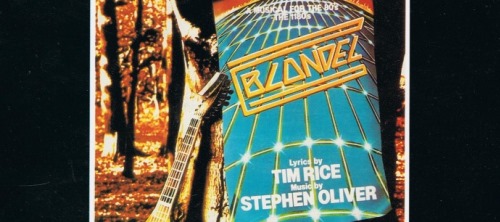
Musical
Musique: Stephen Oliver • Paroles: Tim Rice • Livret: Tim Rice • Production originale: 6 versions mentionnées
Dispo: Résumé Synopsis Génèse Liste chansons
Blondel was one of the first musicals Tim Rice wrote outside the extraordinarily successful partnership with Andrew Lloyd Weber. Teaming up with the brilliant young composer Stephen Oliver, who had written the music for the RSC’s breathtaking adaptation of Nicholas Nickleby, they took on the legend of the twelfth century troubadour Blondel.
Genèse: Tim Rice first envisioned the idea for a show about the Crusades in the early days of his partnership with Andrew Lloyd Webber. Andrew and Tim had done some work on it, entitling the project "Come Back Richard Your Country Needs You". It was performed as an oratorio at the City of London School in 1969 directed by Alan Doggett. Also in 1969 a single of the title song was recorded with Tim as lead vocalist and backed with the unrelated "Roll On Over The Atlantic". After this, however, the idea for a musical about the Crusades sank back into obscurity. Tim Rice first met Stephen Oliver, who had composed for the opera and the RSC, when they both served on a panel at the Sydney Arts Festival in 1977. In 1982 they began collaboration to bring the idea of a musical about King Richard into a reality. Now titled Blondel, the show centered around Richard's minstrel, Blondel, who embarks on a quest to find his missing king . . . while at the same time trying to make it big as a pop singer and songwriter. London Stage Blondel opened in Bath on September 12, 1983 and soon moved to Manchester where it stayed for two weeks before moving to the newly-refurbished Old Vic on November 2. Lord Olivier spoke the prologue at a Gala performance on 8 November. The show remained at the Old Vic for eleven months before moving to the Aldwych on London's West End. Because of high production costs and decreasing revenues, Blondel closed in the Aldwych after only eight months. Original Cast • Blondel - Paul Nicholas • Fiona - Sharon Lee-Hill • Richard - Stephen Tate • John - David Burt • The Assassin - Chris Langham • Leopold - Kevin Williams • The Monks - Cantabile (group) The London revival of the show opened at the Pleasance Theatre on 23 November 2006. The production saw the show revamped and rearranged by Tim Rice and director Patrick Wilde. Young composer Mathew Pritchard took Stephen Oliver's original score and completely rearranged the work, also adding new material. The story was sharpened, particularly in the second act, to produce a punchier (and funnier) version particularly well suited for an ensemble production. 2006 London Cast • Blondel - Chris Grierson • Fiona - Abi Finley • Richard - Mark Inscoe • John - Matt Harrop • The Assassin - Napoleon Ryan • Leopold - David Paul West • Monks - James Durrant, Gavin James, Charlie Tighe, Nick Trumble • The Blondettes - Zoe Harrison, Polli Redston, Rebecca Seale Blondel in the United States The first production of Blondel in the United States was staged at the University of Texas in El Paso by the Union Dinner Theatre. It opened on April 11, 1985. Blondel was again produced in the United States by Farmingdale High School in Long Island, New York during May 1985. Both productions were attended by Tim Rice. Since the mid-1980s, Blondel has been produced by theaters and amateur groups all around the world but has yet to take its place on the Broadway stage.
Résumé: The musical follows the trials and triumphs of Blondel, an ambitious minstrel in King Richard The Lionheart's court desperately trying for a chart-topping song. Blondel and his long-suffering girlfriend Fiona undertake a mulit-nation search when King Richard is taken captive during the Crusades. They rescue him and return to England just in time to prevent the coronation of his shifty brother Prince John.
Création: 9/11/1983 - Old Vic (Londres) - représ.

Musical
Musique: Benny Andersson • Björn Ulvaeus • Paroles: Tim Rice • Livret: Richard Nelson • Production originale: 20 versions mentionnées
Dispo: Résumé Synopsis Commentaire Génèse
Genèse: Tim Rice began thinking about writing a Cold War musical in 1979. He approached Andrew Lloyd Webber about it, but Lloyd Webber was busy with Cats (1981) at the time. In 1980, Rice wrote a five-page synopsis and producer Richard Vos became interested. He helped Rice find Benny Andersson and Björn Ulvaeus, who were looking to branch out from ABBA at the time. The four of them met in Sweden in 1981 and discussed several projects, but it was Chess in which Andersson and Ulvaeus were most interested. While in London on a 10th anniversary tour with ABBA, they announced the project publicly. The song list/stack for the show changes with almost every individual production. Therefore, it's almost impossible to have a finalized song list. In November 1999, a new Broadway production was announced by Tim Rice for the 2000-2001 season. It was to be the definitive Chess, replacing all other version available for staging. An 8-city, 40-week tour was to happen prior to Broadway. This version would be set in 1984 with Anatoly as the focus. Material cut after the original London production would be restored. "Someone Else's Story" would be given to Svetlana, as it had in several productions since the 1991 Australian production. These plans were put on hold as Andersson and Ulvaeus were preparing a reworked concert version in Sweden (work began in 1998 and the concert was presented in 2002).
Résumé: Il est difficile de résumer le livret de Chess et ce, pour plusieurs raisons. En premier lieu, l’oeuvre n’a cessé d’être remaniée. Chaque version propose une histoire et des chansons tout à fait différentes de la précédente. Par ailleurs, l’intrigue commune est des plus compliquées : durant le championnat mondial d’échecs, Freddie Trumper, le tenant du titre américain affronte son challenger, le Russe Anatoly Sergievsky. Florence, l’assistante du premier, tombe amoureuse du second, mariée à Svetlana. Sur fond d’affrontements politiques entre Russes et Américains, la bataille approche… Elle se jouera aux quatre coins de la planète (dans des lieux différents selon les versions) : on passe de Merano (en Italie) à Bangkok ou Budapest.
Création: 14/5/1986 - Prince Edward Theatre (Londres) - représ.

Musical
Musique: Andrew Lloyd Webber • Paroles: Tim Rice • Livret: Tim Rice • Production originale: 2 versions mentionnées
Dispo: Résumé Synopsis Génèse Liste chansons
Genèse: After their collaboration on Evita in 1978, composer Andrew Lloyd Webber and lyricist Tim Rice took what was originally intended to be a temporary break from their illustrious theatrical partnership. They did not work together again until the request for this pièce d'occasion came up, and Cricket ended up being their final original musical. Prince Edward, the Queen's youngest son, had joined Lloyd Webber's Really Useful Theatre Company as staff assistant in 1986. He commissioned a short musical from Lloyd Webber and Rice for his mother's 60th birthday celebration. The game of cricket was Tim Rice's favourite pastime – he had a cricket field on the grounds of his home and had his own cricket team – and Rice had a particular passion for this new comic musical about England's national sport. Rice used actual cricket-related names for his characters, boosting the light-hearted feeling of the piece. He and Lloyd Webber created a 25-minute tongue-in-cheek "musicalette" for the Queen. Cricket is entirely sung-through, with no spoken dialogue. The show debuted as planned on 18 June 1986 at Windsor Castle, directed by Trevor Nunn and starring Ian Charleson, Sarah Payne, and John Savident. The musicians were members of Colosseum II and others – the ensemble that had first performed Lloyd Webber's Variations. The men's vocal group Cantabile played the cricketers' chorus. The Windsor Castle performance was quite spirited and amusing, and was very well received. Two more performances followed. One was at Lloyd Webber's Sydmonton Festival on 15 July 1986. Another performance followed in November 1986 at Tim Rice's favourite charity, the Lord's Taverners Ball, where Rice played the cricketer Wittering, dressed in his own Heartaches Cricket Club uniform. A segment of the original rehearsals of Cricket was televised on the Andrew Lloyd Webber installment of The South Bank Show, which aired on 15 November 1986. The segment featured Sarah Payne and Alvin Stardust rehearsing "As the Seasons Slip Fruitlessly By" and "The Sport of Kings". There have been no further performances of the musical. Lloyd Webber used at least five of the tunes from Cricket in his musical Aspects of Love (1989). This meant that Cricket, which had been extremely well received, was a dead item, a fact that greatly distressed Tim Rice. The piece could thus never be expanded into a full theatrical musical. Lloyd Webber used other tunes from Cricket in Sunset Boulevard. The Cricket libretto was published in 'A Breathless Hush ...': The MCC Anthology of Cricket Verse (2004). Cricket has not been recorded for commercial release, although a non-commercial instrumental demo studio album was recorded on solo piano in 1986. The performance rights for the piece have not yet been made available. The men's vocal group Cantabile recorded "The Summer Game", featuring Tim Rice singing as the Earl, on their 2011 CD Songs of Cricket.
Résumé: Set against the backdrop of the semi-fictional Headingley Cricket Club's matches, the comic and slightly melodramatic plot of Cricket has star player Donald torn between his team and his girlfriend Emma – as she decides to abandon watching cricket for what appears to be a far more exciting life at the race track with the caddish Vincent. The leads in the cast are Donald, Emma, Emma's father, Vincent, and a West Indian fast-bowler from the opposing team named Winston B. Packer. The musical's chorus are the rest of the cricket players
Création: 18/6/1986 - Windsor Castle (Londres) - représ.
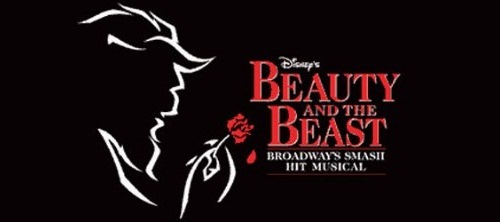
Musical
Musique: Alan Menken • Paroles: Howard Ashmand • Tim Rice • Livret: Linda Woolverton • Production originale: 35 versions mentionnées
Dispo: Résumé Synopsis Commentaire Génèse Isnpiration Liste chansons
According to an article in The Houston Chronicle, "The catalyst for Disney's braving the stage was an article by New York Times theater critic Frank Rich that praised Beauty and the Beast as 1991's best musical.... Theatre Under The Stars executive director Frank Young had been trying to get Disney interested in a stage version of Beauty about the same time Eisner and Katzenberg were mulling over Rich's column. But Young couldn't seem to get in touch with the right person in the Disney empire. Nothing happened till the Disney execs started to pursue the project from their end.... When they asked George Ives, the head of Actors Equity on the West Coast, which Los Angeles theater would be the best venue for launching a new musical, Ives said the best theater for that purpose would be TUTS. Not long after that, Disney's Don Frantz and Bettina Buckley contacted Young, and the partnership was under way."
Genèse: Beauty and the Beast, the musical, is based on the 1991 Disney film of the same name. Seven new songs were written for the stage musical. Beauty ran on Broadway for 5,464 performances between 1994 and 2007, becoming Broadway's eighth-longest running production in history. The musical has played in thirteen countries and 115 cities. Beauty and the Beast premiered in a joint production of Theatre Under The Stars and Disney Theatricals at the Music Hall, Houston, Texas, from November 28, 1993, through December 26, 1993. Original Broadway production) The musical opened on Broadway at the Palace Theatre on April 18, 1994 and ran there until September 5, 1999, transferring to the Lunt-Fontanne Theatre on November 11, 1999, with an official opening date of November 16, 1999. The musical closed on July 29, 2007 after 46 previews and 5,464 performances, and is Broadway's eighth-longest running production in history (as of August 2011). The production holds the record of being the longest running production at both the Palace Theatre, where it opened, and the Lunt-Fontanne Theatre, where it closed its Broadway run. Directed by Robert Jess Roth with choreography by Matt West and assisted by Dan Mojica, the original Broadway cast included Susan Egan as Belle, Terrence Mann as the Beast, Burke Moses as Gaston, Gary Beach as Lumiere and Beth Fowler as Mrs Potts. Orchestrations were by Danny Troob (after his score of the film), scenic designer was Stan Meyer, costume designer Ann Hould-Ward, lighting designer Natasha Katz, sound was by T. Richard Fitzgerald, hair designer David H. Lawrence, and prosthetics were by John Dods. Illusions were by Jim Steinmeyer and John Gaughan, and pyrotechnic design was by Tyler Wymer. The Broadway production closed to make way for Disney's next musical venture, The Little Mermaid. With Disney set to open its Broadway version of The Little Mermaid on November 3, 2007 at the time, it was believed that having two Disney film of the same style I.E. Princesses on Broadway at the same time would divide audiences and cause competition between the two shows. At this point, Disney had three shows running at the same time: Beauty and the Beast, The Lion King, and Tarzan. It was reported that Disney Theatrical planned to revive the show on Broadway for the 2008 holiday season, but Disney did not pursue this. Original London production The West End production opened at London's Dominion Theatre on April 29, 1997 and closed on December 11, 1999. Featured were Julie Alanah Brighton as Belle, Alasdair Harvey as the Beast, Burke Moses reprising his role as Gaston, Derek Griffiths as Lumiere, Mary Millar as Mrs Potts, Norman Rossington as Maurice, Barry James as Cogsworth, Di Botcher as Madame De La Grande Bouche, Richard Gauntlett as Lefou and Rebecca Thornhill as Babette. Notable replacements included Michelle Gayle and Annalene Beechey as Belle and John Barrowman and Earl Carpenter as the Beast, Alex Bourne as Gaston and Terry Doyle as Maurice. The show won the Olivier Award as Best New Musical for 1998. National tours The show had three US national tours. The first opened on November 15, 1995 and closed in 1999. It featured Kim Huber as Belle and Fred Inkley as the Beast. The second national tour opened in 1999 with Susan Owen as Belle and Grant Norman as The Beast. This production closed in 2003. The third national tour opened in 2001 and closed in 2003. This production starred Jennifer Shraeder as Belle and Roger Befeler as the Beast. Notable replacements on the tours have included Sarah Litzsinger, Erin Dilly and Danyelle Bossardet as Belle. The three touring companies visited 137 venues in 90 North American cities. About 5.5 million people in the United States and Canada saw these tours. A fourth national tour of Beauty and the Beast began February 2010, opening in Providence, Rhode Island starring Liz Shivener as Belle and Justin Glaser as The Beast. The UK National tour (prior to the closure of the West End Production in 1999) began on November 2, 2001 at the Empire Theatre in Liverpool with stops in Bristol, Birmingham, Dublin, Southampton, Manchester and ended on April 12, 2003 at the Playhouse Theatre in Edinburgh. The tour starred Annalene Beechey (reprising her role from the London Production) as Belle, Alistair Robins as the Beast, Ben Harlow as Gaston, Julia Goss as Mrs Potts, Stephen Matthews as Lumiere Barry James (reprising his role from the London Production) as Cogsworth, Billy Boyle (reprising his role from the London Production) as Maurice, Karen Davies as Madame De La Grande Bouche, Kate Graham (reprising her role from the London Production) as Babette, Anthony Clegg as Lefou and Oliver Taylor and Sion Eifion sharing the role of Chip. Notable replacements included Dianne Pilkington as Belle, Alex Bourne as the Beast, Earl Carpenter as Gaston, Marilyn Cutts as Mrs Potts, Richard Tate as Maurice and Drew Varley as Lefou. In October 2005, UK Productions produced a UK Tour of the show which ended in January 2010. The original cast included Katie Rowley Jones as Belle, Nic Greenshields as The Beast and Michael Quinn as Gaston. Notable replacements have included Jo Gibb and Ashley Oliver as Belle, Matthew Cammelle and Shaun Dalton as the Beast and Ben Harlow (who reprised his role from the Original Disney UK Tour as Gaston). The tour also visited other countries such as Malaysia and Greece. Other productions Los Angeles: A Los Angeles production opened at the Shubert Theatre on April 12, 1995 and closed on September 29, 1996. Most of the original Broadway cast, including Susan Egan, Terrence Mann, Gary Beach, Beth Fowler, Burke Moses and Tom Bosley reprised their roles. Notable replacements included James Barbour as the Beast. The sets in this production were widely considered to be the largest out of all the musical's productions in the world. After the show closed in Los Angeles, all of the sets were transferred for the production in Mexico City in 1997.[citation needed] Canada: The Toronto production opened at the Princess of Wales Theatre on August 8, 1995 and closed in 1998. The production starred Kerry Butler as Belle and Chuck Wagner as the Beast, and Terry Doyle as Maurice. Notable replacements included Melissa Thomson as Belle and Steve Blanchard as the Beast. The lesser known Halifax production at the Neptune Theatre was the longest running production in the theatre's history. International productions In 1995, the musical began its original Australian run in Melbourne at The Princess Theatre, before moving on to Sydney. The original Australian cast included Michael Cormick as The Beast, Rachael Beck as Belle, Hugh Jackman as Gaston, and Ernie Bourne as Maurice. In South America, Brazil was the second country to host the musical. Disney had plans to bring it to the country in 1999, after the success in Argentina, but nobody really knew if it would work. Three years later, in 2002, Beauty and the Beast finally opened in Brazil at Teatro Abril, one of the biggest theaters in the country. It was a huge hit, for more than one and a half years, it was presented with Kiara Sasso, playing Belle and Saulo Vasconcelos playing the Beast. In 2009, a new Belle and a new Beast were cast, Lissah Martins and Ricardo Vieira, as the musical came back to Brazil, Kiara Sasso was playing Maria in The Sound of Music and Saulo was Captain Von Trapp. Beauty and the Beast remained for six months at Teatro Abril. Even though the play was brought back as a way to try to recoup some of the money lost in Brazilian's version of Miss Saigon, this second encarnation of Beauty And The Beast failed to create any critical buzz, or to be a Box Office success. In Spain there have been two productions of the show. The first one, based on the original Broadway production, had its Madrid debut on December 2, 1999 at Teatro Lope de Vega. The original cast included Xenia Reguant (later replaced by Julia Möller) as Belle, Carlos Marín (later replaced by Joe Luciano) as Beast, Lisardo Guarinos (later replaced by Manuel Bandera) as Gaston, Víctor Ullate Roche as Lefou, Germán Torres as Lumiere, Kirby Navarro as Mrs Potts, David Venancio Muro as Cogsworth, Dulcinea Juárez as Babette, Laura Inclán as Madame de la Grande Bouche and Miguel de Grandy as Maurice. After a successful run of 27 months and about 900 performances, the production finally closed on March 3, 2002, becoming the longest-running musical ever in Madrid. More recently, its record was surpassed by Mamma Mia!, Hoy no me puedo levantar and Sam Mendes' Cabaret. In 2007, a second version produced by Stage Entertainment premiered on October 3, at Teatro Coliseum, Madrid, for a limited run of 6 months, but the closing was postponed due to a successful season. The original cast included Julia Möller reprising her role as Belle (later replaced by María Adamuz), David Ordinas as Beast, Pablo Puyol as Gaston, Raúl Peña as Lefou, Armando Pita as Lumiere, Angels Jiménez as Mrs Potts (later replaced by Rita Barber), Esteban Oliver as Cogsworth, Silvia Luchetti as Babette, María José Oquendo as Madame de la Grande Bouche and Lorenzo Valverde as Maurice. The production closed on January 11, 2009 and was transferred to Barcelona, where it ran from February 26, 2009 to January 10, 2010, at BTM, with some changes in the cast, including Mercè Martínez as Mrs Potts, Marta Capel as Babette and Albert Muntanyola as Maurice. According to Disney, Beauty and the Beast has performed around the world in a total of 14 countries in 116 cities including Argentina (1998 and 2010), Australia (1995), Austria (1995), Brazil (2001 and 2009), Canada (1995), China (1999), Germany (1997), Ireland (2002 as part of the UK National Tour), Japan, (1995), Mexico (1997), Israel (2006), South Korea (2004), Spain (1999 and 2007), Poland (2008) and the United Kingdom (1997). In 2005, Disney and Stage Entertainment produced a new version of the show using brand new sets and costumes. After touring Holland and playing in Antwerp, Belgium, Disney and Stage Entertainment brought the show to Berlin, Germany in 2006 after a (aprox.) one year-run at the Metronom Theater in Oberhausen. This production opened in 2007 in Madrid, Spain and in 2009 in Milan, Italy, with Arianna as Belle and Michel Altieri as the Beast. The Broadway production played a second time in Mexico City beginning in September 2007 and in Hiroshima, Japan beginning in February 2008. It opened in South Africa in September 2008. In 2004, Disney began to license the show to other companies for touring, and the show has been performed by professional and amateur companies in many countries.
Résumé: Pour sauver son père, enfermé au château d'une bête monstrueuse, Belle accepte d'être emprisonnée à sa place. La Bête n'est en fait qu'un malheureux prince, victime d'un sort. La rose enchantée qu'il possède perd un à un ses pétales et sa seule chance de redevenir humain est d'aimer et d'être aimé en retour avant la chute du dernier pétale. Belle fait la connaissance des habitants du château, eux aussi sous le coup du sort qui les transforme peu à peu en objets. Tous se liguent - avec succès - pour que les deux jeunes gens tombent amoureux l'un de l'autre et brisent la malédiction mais c'est compter sans Gaston. Ce bellâtre veut épouser Belle et tuer La Bête. A l'issue d'un terrible combat sur le toit du château, Gaston est précipité dans l'abîme mais la Belle est blessée au moment où le dernier pétal tombe. Mais le pouvoir de l'amour est si fort qu'il redonne à La Bête son apparence initiale et Belle et lui peuvent enfin se marier.
Création: /11/1993 - Theatre Under the Stars (Houston) - représ.
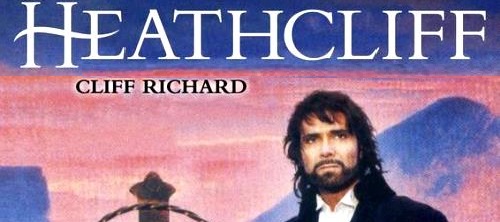
Musical
Musique: John Farrar • Paroles: Tim Rice • Livret: Cliff Richard • Frank Dunlop • Production originale: 2 versions mentionnées
Dispo: Synopsis Génèse
Genèse: Sir Cliff Richard had wanted to do something with the character Heathcliff from Emily Bronte's novel Wuthering Heights for years. He had also been aquatinted with Tim Rice for years, knowing him from his days with Norrie Paramor. In 1991, Tim received a call from Cliff Richard with a proposition -- how would he like to write the lyrics to an album about Heathcliff? Already onboard the project was John Farrar (Farrar had worked with former Shadows members Hank Marvin and Bruce Welch, and had written and produced many of Olivia Newton John's hits). Olivia Newton John had said she would sing the part of Cathy on the album. The plan was to turn what would start out as an album into a concert show, with Frank Dunlop directing. Tim, needless to say, agreed. What emerged was the concept album Songs From Heathcliff. The album (classified as Cliff Richard songs rather than as a show starring Cliff Richard), was released in October of 1995. The first single released was "Misunderstood Man", which entered the UK charts in October at number 19. It even found it's way onto the popular BBC soap EastEnders as background music for a scene. "Had To Be" was released on 2 November, entering at number 22. A new version of "I Do Not Love You Isabella" (rather than the track from the Songs From Heathcliff album) titled "The Wedding" was released on 18 March 1996. Featuring Helen Hobson who had just been signed on to portray Cathy for the show, the single entered the charts at number 40. Heathcliff had trouble making play lists because it was too rock/pop for some stations, and too non-rock/pop for the others. Record-Breaking Ticket Sales A 22 week UK tour of the concert began on 16 October 1996 in Birmingham, and then moved to Edinburgh, Manchester, and London. The dates for the concerts were announced in early March. Cliff Richard visited all three locations, and with Tim Rice, sold tickets. Heathcliff set records the first day tickets for the tour were available on Monday 4 March 1996 by raking in £2,305,00. Six extra weeks had to be added immediately to the tour because the tickets sold out so fast. A Heathcliff Hotline was set up for tickets for all locations at 0990-203020. Even with the extra dates, the demand for Heathcliff could not be met, so a return to Birmingham Academy from Saturday 14 December to Thursday 19 December 1996 was later added to the tour. Two commemorative stamps featuring Cliff Richard were released when tickets went on sale. One was a profile of Cliff Richard, and the other had the picture from the Songs From Heathcliff album on it. Show Details Fall Into Place At first the papers declared that critics were to be barred from the show. Cliff Richard responded that he had never intended to keep critics from seeing the show, he just wanted to give his fans top priority. If there were tickets left, the critics were more than welcome to have them. It was announced at a Heathcliff press conference in London on Sunday 3 March 1996 that Helen Hobson would play Cathy. Backing vocals would be supplied by Mick Wilson, John Perry and David Combes; the band would be composed of John Clark, Keith Hayman, Peter May, Bob Noble, Alan Park and Steve Stroud. Mike Moran would be the musical director, and the show would be choreographed by Brad Jeffries. Rehearsals began on 2 September 1996. The show, presented by the Cliff Richard Organisation, opened on 16 October 1996 at the National Indoor Arena at Birmingham as planned, and was much expanded from the original Cliff Richard album. Lyrics and music, of course, were by Tim Rice and John Farrar respectively. The book was by Cliff Richard and Frank Dunlop. Frank Dunlop also directed, choreography was by Brad Jeffries, production design was by Joe Vanek, and lighting design was by the ubiquitous Andrew Bridge. Musical direction for the production was by Mike Moran. The show starred Cliff Richard as Heathcliff, Helen Hobson as Cathy, Darryl Knock as Edgar, and Jimmy Johnston as Hindley. Due to the complexity of the production, Heathcliff was not able to move from Birmingham Academy to Edinburgh Playhouse by 5 November as originally planned. Instead, the show opened at the Edinburgh Playhouse the next day, Wednesday 6 November. A special matinee performance at 2.30 on Saturday 9 November 1996 was added for all of the fans who had purchased tickets for the performance on the 5th. Among the publicity for the show was a full page colour advertisement on the first page of the 1996-1997 issue of the Dress Circle catalogue. Tour Success Leads To Additional Dates The single "Be With Me Always" featuring Cliff Richard and Helen Hobson which was to be released on 4 November 1996, was released instead on 13 January 1997. The double CD cast album, produced by John Farrar and recorded live at Earls Court Hall (where rehearsals were held) and the Academy at the National Indoor Arena (Birmingham) by the BBC Radio International Mobile, (originally due to be released on 18 November and then 9 December) was released on 2 December 1996. An extra tour date for Heathcliff was scheduled for The Academy at the NIA, Birmingham on Friday 13 December 1996. (The extended date had at first been set for Saturday 14 December 1996.) A month's worth of extra dates were also added for Labatt's Apollo, Hammersmith (London) from Monday 7 April to Saturday 3 May 1997. The box office for those performances opened on Saturday 30 November 1996 at 10 A.M.. Two further weeks of performances were added after Easter for Hammersmith (London), with tickets going on sale 4 April 1997, making the last night of Heathcliff Saturday 17 May 1997. There were no Sunday performances. The show was not open on 5 May (Monday), 6 May (Tuesday), 12 May (Monday), 13 May (Tuesday) when it was being taped for commercial release. A voucher for a £8 discount on the top two ticket prices (not valid on Friday and Saturday) was offerred, and could be obtained by sending a s.a.s.e. (with a first class stamp) to: Heathcliff Voucher Office, PO Box 46C, Esher, Surrey KT10 0RB, England. In mid April 1997, Tim Rice and Cliff Richard received awards for combined platinum (300,000+) sales of the two Heathcliff albums. In the seven months that Heathcliff played, it was seen by a half million people.
Résumé:
Création: 16/10/1996 - National Indoor Arena (Birmingham) - représ.

Musical
Musique: Elton John • Paroles: Tim Rice • Livret: Irene Mecchi • Roger Allers • Production originale: 9 versions mentionnées
Dispo: Résumé
Vidéos:
Genèse:
Résumé: Scar dispute la Terre des lions à son frère le roi Mufasa. Simba, le fils de ce dernier, grandit insouciant jusqu’à la mort accidentelle de son père dont il se croit – à tort – responsable. Il s’enfuit et mène loin de la savane une vie insouciante avec ses amis Timon et Pumbaa jusqu’au jour où son amour d’enfance, Nala, le convainc de reprendre sa place parmi les siens. A l’issue d’un terrible combat contre son oncle Scar, Simba est adoubé Roi lion.
Création: 15/10/1997 - New Amsterdam Theatre (Broadway) - représ.
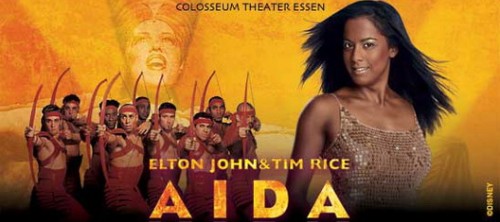
Musical
Musique: Elton John • Paroles: Tim Rice • Livret: David Henry Hwrang • Linda Woolverton • Robert Falls • Production originale: 25 versions mentionnées
Dispo: Résumé Synopsis Commentaire Génèse Liste chansons
Vidéos:
La comédie musicale d'Elton John et de Tim Rice a triomphé à Broadway. Trouver des places a longtemps tenu du miracle tant le succès populaire a été important. Elle a même remporté 4 Tony Awards, celui de la meilleure musique originale, des meilleurs décors, des meilleures lumières et son interprète, Heather Headley, celui de la meilleure actrice. Mais quel parcours semé d'embûches pour en arriver là. Rarement un musical de cette envergure a eu un accouchement aussi long et difficile. D'écritures en réécritures, de décors chamboulés en acteurs remplacés, elle aura fait couler beaucoup d'encre. Sans parler de la fameuse colère publique d'Elton qui s'était levé et avait quitté la salle lors de la première car l'on avait pas respecté son désir de retirer une partie qu'il jugeait trop "techno" et qu'il n'avait jamais écrite. Après Broadway, Aida a fait un triomphe en Hollande et en Allemagne, sans parler du Japon. Un musical a découvrir de toute urgence…
Genèse: Pre-Broadway: Origins, Atlanta and Chicago Aida was originally conceived for production as an animated musical film by Disney executives, who wanted to do another project with the collaborative team of Sir Elton John & Sir Tim Rice, following the success enjoyed by the animated film The Lion King. Disney wanted to do another animated feature, and it was John's idea to develop the story directly as a musical. A first reading was presented to Disney executives on April 1, 1996. John also recorded multiple demos of the original songs, which were never released but were widely bootlegged. Early readings featured Simone(Aida) Hank Stratton(Radames)and Sherrie Rene Scott(Amneris). It took 2 1/2 years from first reading, to first full production presentation in September 1998 in Atlanta. One of the many issues was what to call the musical. Elaborate Lives: The Legend of Aida had its world premiere at the Alliance Theatre in Atlanta, Georgia with the production running from September 16 to November 8, 1998.[3] The Atlanta production featured Heather Headley (Aida), Hank Stratton (Radames) and Sherie Rene Scott (Amneris). The production featured several songs which were cut from the final production. The original Atlanta staging conceived of the play with a nearly empty set, displaying only a six-ton gold pyramid-shaped set piece in the center. Driven by hydraulic controls, the pyramid's sides and bottom could be turned and rotated to suggest various locations such as a ship stern or a tomb. However, the piece, constructed at a price of nearly $10 million, frequently broke down, and a new production designer was hired for restaging in Chicago. Nothing of the original Atlanta set design remained in the new production. A new, revised production opened on November 12, 1999 at the Cadillac Palace in Chicago and ran through January 9, 2000.[4][5] Aida producers made substantial changes to its team for the Chicago production. From the Atlanta staging, only Heather Headley, as Aida, and Sherie Rene Scott, as Amneris, remained. Adam Pascal joined the cast as Radames for the Chicago run. Robert Falls took over as director in Chicago, replacing Robert Jess Ross; and set designer Bob Crowley replaced Stanley A. Meyer. Also part of the new Chicago team was choreographer Wayne Cilento. The Chicago production featured one number "Our Nation Holds Sway", originally performed near the beginning of both act 1 and act 2, which was cut from the final Broadway production. During the Chicago run at the Cadillac Theatre, on November 13, 1999, a set mishap during the final moments of the performance injured stars Headley and Pascal. According to an eyewitness report, while the two actors were being conveyed in a suspended boxlike "tomb" at the climax of the show, the set piece broke from its support and plunged approximately eight feet to the stage. A subsequent press release from the show's publicist stated that Headley and Pascal sustained minor injuries and were taken to Northwestern Memorial Hospital for examination. Both were released from the hospital a few hours later. From then on, the tomb remained on the ground. Broadway The musical, now titled Elton John and Tim Rice's Aida, premiered on Broadway at the Palace Theatre on March 23, 2000 and closed on September 4, 2004 after 1,852 performances and 30 previews. The run ranks it as 34th in the longest runs in Broadway history.[7] Directed by Robert Falls, and choreographed by Wayne Cilento, scenery and costumes were designed by Bob Crowley and the lighting design by Natasha Katz. Considered by its producers to be a financial success, Aida on Broadway recovered its investment in 99 weeks, and generated a profit of $12 million.[8] Heather Headley originated the title role of Aida. Headley won the Tony Award for Best Actress in a Musical in 2000 for her performance in this role. Headley also received broad critical acclaim for her performance. Adam Pascal played the role of Radames in both the OBC and closing productions of Aida on Broadway. Sherie René Scott, who was with the project since its first workshop, originated the role of Amneris, and was named the Most Promising Actress in 2000 for her performance (Clarence Derwent Award). The cast also included Tyrees Allen (Amonasro), John Hickok (Zoser), Daniel Oreskes (Pharaoh), Damian Perkins (Mereb), and Schele Williams (Nehebka). Pop stars, including Deborah Cox, Toni Braxton and Michelle Williams played the title role of Aida during its run on Broadway, as well as Maya Days, Saycon Sengbloh, Simone and Merle Dandridge. Notable replacements for Radames included Will Chase, Patrick Cassidy, Richard H. Blake, William Robert Gaynor, and Matt Bogart. Notable replacements for Amneris included Idina Menzel, Jessica Hendy, Mandy Gonzalez, Felicia Finley, Taylor Dayne and Lisa Brescia; and Mickey Dolenz and Donnie Kehr as Zoser. US National tours Elton John and Tim Rice's Aida also had a critically acclaimed US National tour from March 2001 to 2003.[10] The show won awards in 2002 for Best Musical, Best Actress (Simone), and Best Actor(Patrick Cassidy) from the National Broadway Theatre Awards (now called "Touring Broadway Awards". The National tour also featured Kelly Fournier(Amneris). Notable replacements included Jeremy Kushnier(Radames) and Lisa Brescia (Amneris). The musical also had a non-equity US national tour during 2006-2007 featuring Marja Harmon (Aida) Casey Elliott (Radames) and Leah Allers (Amneris). This production had a revised script by Henry David Hwang authorized by Disney. The new script was considered to be more serious and darker, with much of the shticky and comedic elements removed from Amneris' character especially. 'Strongest Suit' was staged as a scene in which Aida helped Amneris chose her outfit for the evening instead of a random fashion show. The scene prior to 'Strongest Suit Reprise' was revised with Aida teaching Amneris how to thread, adding more a sense of bond between the women and also humbling Amneris in wanting to learn something new and not just 'be a princess.' Introduced to the plot was the revelation that Radames' mother was a prostitute and that Zoser treated her as such and fought and schemed for Radames to achieve his position of Captain of Phaoroh's armies.
Résumé: Aïda, une princesse Nubienne, est capturée par un capitaine égyptien, Radames. Ignorant son rang, il tombe vite amoureux d'elle et la sauve de la rude vie d'esclave en l'attachant au service de sa future épouse, la princesse égyptienne Amneris. Aïda est l'histoire de trois personnes qui sont forcées de faire des choix difficiles qui changeront l'histoire à jamais.
Création: 17/9/1998 - Alliance Theatre (Atlanta) - 1852 représ.
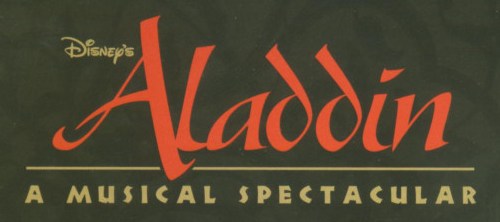
Musical
Musique: Alan Menken • Paroles: Howard Ashman • Tim Rice • Livret: *** Divers *** Divers • Production originale: 1 version mentionnée
Dispo: Synopsis Génèse Isnpiration Liste chansons
Ce spectacle se joue à l'Hyperion Theater, un théâtre de plus de 2000 places situé au pied de la Tower of Terror au bout de la reproduction de l'Hollywood Boulevard, dans le parc Disney California Adventure en Californie. La salle rappelle les salles du début du XXe siècle ainsi que les théâtres classiques. Durant le spectacle, très inspiré des comédies musicales de Broadway, plusieurs des scènes et chansons du film Aladdin (1992) sont reproduites sur scène. Alan Menken composa une chanson supplémentaire pour ce spectacle nommée To Be Free. Les scènes présentées utilisent des accessoires comme des tapis volants, une têtre de tigre géante,... Le spectacle possède aussi une particularité qui le rend très populaire : les dialogues du Génie ne sont pas fixe et reflèete la culture populaire.
Genèse: The production is a Broadway-type show. Many of the classic scenes and songs from the movie are re-created on stage and some of the action even spills out into the aisles, like Prince Ali's jubilant arrival in Agrabah on elephant back. Flying carpets, magic lamps, wise-cracking genies, princesses, and evil wizards - are all a part of this musical production. This 45 minute production takes place in the 2,000 seat Hyperion Theater, located at the end of Hollywood Blvd. The exterior has design features reminiscent of many classic theaters. Alan Menken composed and wrote lyrics for a new song for this production, called To Be Free. The show has been quite popular because while much of it is scripted, the dialogue of the Genie constantly changes to reflect popular culture. When Disney's California Adventure opened, an original Disney musical called Disney's Steps in Time was on stage at the Hyperion. A scaled-down version of the musical Blast! Followed.
Résumé:
Création: 16/1/2003 - Hyperion Theater (Disney's California Adventure.) - représ.
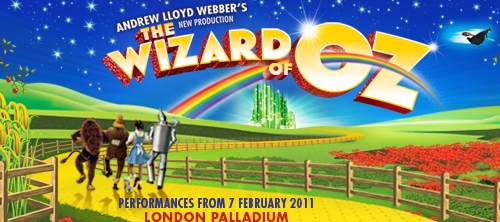
Musical
Musique: Andrew Lloyd Webber • E.Y. Harburg • Harold Arlen • Paroles: E.Y. Harburg • Harold Arlen • Tim Rice • Livret: Jeremy Sams • L. Frank Baum • Production originale: 2 versions mentionnées
Dispo: Synopsis Génèse Liste chansons
Genèse: The Wizard of Oz was first turned into a musical extravaganza by Baum himself. A loose adaptation of his 1900 novel (there is no Wicked Witch or Toto, and there are some new characters), it first played in Chicago in 1902 and was a success on Broadway the following year. It then toured for nine years. The 1939 film adaptation bore a closer resemblance to the storyline of Baum's original novel than most previous versions. It was a strong success, winning the Academy Awards for best song and best score, and continues to be broadcast perennially. Among the many musical theatre adaptations of The Wizard of Oz, two previous ones have used the songs from the film. In 1945, the St. Louis Municipal Opera (MUNY) created a version with a script adapted by Frank Gabrielson from the novel, but it is influenced in some respects by the motion picture screenplay. It uses most of the songs from the film. This was followed, in 1987, by a Royal Shakespeare Company (RSC) adaptation designed to more closely recreate the film version. The book by John Kane closely follows the film's screenplay, and it and uses nearly all of the film's music. Both the MUNY and RSC adaptations were successes and have been revived numerous times in the U.S. and UK. The Wizard of Oz is Andrew Lloyd Webber's 18th musical. Tim Rice first collaborated with Lloyd Webber in 1965, together writing The Likes of Us. Their next piece was Joseph and the Amazing Technicolor Dreamcoat, followed by two more concept albums that became hit musicals, Jesus Christ Superstar (1971) and Evita (1978). Except for a special collaboration for Queen Elizabeth's 60th birthday celebration, the musical Cricket in 1986, after Evita, each man turned to other collaborators to produce further well-known musical theatre works. The Wizard of Oz was Rice and Lloyd Webber's first production together in the West End in over three decades. To create the new musical, Lloyd Webber and director Jeremy Sams adapted the 1939 film's screenplay, and Rice and Lloyd Webber added several new songs to the film's score. In July 2010, Lloyd Webber told the Daily Mail, "The fact is that The Wizard of Oz has never really worked in the theatre. The film has one or two holes where in the theatre you need a song. For example, there's nothing for either of the two witches to sing." "Tim and I are doing quite a specific thing, because we know what's missing." Productions After previews beginning 7 February, the musical opened in the West End, at the London Palladium, on 1 March 2011. The role of Dorothy was originally played by Danielle Hope, who was selected through the reality television show Over the Rainbow, and the title role of the Wizard was created by Michael Crawford. Over the Rainbow runner-up Sophie Evans performed the role of Dorothy on Tuesday evenings and when Hope was ill or on holiday. Hannah Waddingham originated the role of the Wicked Witch of the West leaving the cast on September 2011, when her understudy, Marianne Benedict assumed the role. Hope and Crawford left the production on 5 February 2012. Evans replaced Hope in the role of Dorothy full-time beginning 7 February 2012, and Russell Grant took over as The Wizard a week later, for 14-weeks. Des O'Connor played The Wizard from May 2012 until the production closed. The musical was produced by Lloyd Webber and Bill Kenwright, with direction by Jeremy Sams, choreography by Arlene Phillips and sets and costumes by Robert Jones. It took in pre-opening sales of £10 million. The production celebrated its 500th performance on 9 May 2012 and closed on 2 September 2012. An autumn 2012 reality TV show, Over the Rainbow, hosted by Daryn Jones, searched for a Canadian girl to play the role of Dorothy in a forthcoming Toronto staging by Mirvish Productions. On 5 November 2012, viewers chose Danielle Wade, a 20-year-old University of Windsor acting major, to play the role of Dorothy, with Stephanie La Rochelle as 1st runner up. The production premiered on 20 December 2012 at the Ed Mirvish Theatre with an official opening night on 13 January 2013. The cast also includes Cedric Smith as Professor Marvel/the Wizard, Lisa Horner as Miss Gulch/The Wicked Witch of the West, Mike Jackson as the Hickory/Tin Man, Lee MacDougall as the Zeke/Cowardly Lion, Jamie McKnight as Hunk/the Scarecrow and Robin Evan Willis as Glinda. The production is then expected to begin touring North America in autumn 2013 with the original Canadian cast.
Résumé:
Création: 1/3/2011 - Palladium Theatre (Londres) - représ.
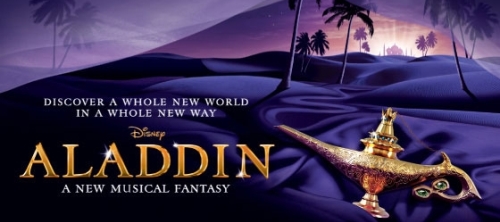
Musical
Musique: Alan Menken • Paroles: Chad Beguelin • Howard Ashman • Tim Rice • Livret: Chad Beguelin • Production originale: 4 versions mentionnées
Dispo: Synopsis Commentaire Génèse Liste chansons
Vidéos:
Aladdin is a musical based on the 1992 Disney animated film of the same name with music by Alan Menken and lyrics by Howard Ashman, Tim Rice and Chad Beguelin. Beguelin also wrote the book. The musical includes three songs written for the film by Ashman but not used there and four new songs written by Menken and Beguelin. The story follows the familiar tale of how a poor young man discovers a genie in a lamp and uses his wishes to marry the princess that he loves and to thwart the Sultan's evil Grand Vizier.
Genèse: In November 2010 Alan Menken confirmed that a musical theatre adaptation of the movie was in the works with a book written by Chad Beguelin. The musical premiered in Seattle, Washington, at the 5th Avenue Theatre from July 7–31, 2011. Jonathan Freeman, who voiced Jafar in the film, played the role in the stage adaptation. Adam Jacobs and Courtney Reed played Aladdin and Jasmine. Additional cast included James Monroe Iglehart as Genie; Clifton Davis as the Sultan; Don Darryl Rivera as Iago; and, playing Omar, Kassim and Babkak, a trio of characters originally conceived by the film's creators but not used, were Andrew Keenan-Bolger, Brian Gonzales and Brandon O'Neill, respectively. The show was directed and choreographed by Casey Nicholaw. In 2012, productions of the musical played at the Tuacahn Amphitheatre in Ivins, Utah from June–October 2012 and the The Muny in St. Louis in July 2012. In 2012, Aladdin was staged in Manila, the Philippines at the Meralco Theater. Directed by Bobby Garcia and Chari Arespacochaga, it starred Tom Rodriguez as Aladdin and featured Aiza Seguerra as Genie. The musical was staged in Spanish in Bogotá, Colombia in 2013. Aladdin had a pre-Broadway tryout at the Ed Mirvish Theatre in Toronto, Ontario from November 2013 to January 2014. Nicholaw again directed and choreographed, with book and additional lyrics by Beguelin, scenic design by Bob Crowley, and costume design by Gregg Barnes. The musical premiered on Broadway on February 26, 2014 in previews and officially opened on March 20, 2014 at the New Amsterdam Theatre, taking the place of Mary Poppins. The show was nominated for five Tony Awards, winning one for Best Performance by a Featured Actor in a Musical for James Monroe Iglehart. The cast album was nominated for the Grammy Award for Best Musical Theater Album.
Résumé:
Création: 7/7/2011 - 5th Avenue Theatre (Seattle) - représ.

Musical
Musique: Stuart Brayson • Paroles: Tim Rice • Livret: Bill Oakes • Production originale: 2 versions mentionnées
1
Dispo: Résumé Isnpiration
Vidéos:
Genèse:
Résumé: From Here to Eternity is set on the Hawaiian island of Oahu in 1941, before and during the attack on Pearl Harbor. Loosely based on Jones' own wartime experiences, the story follows several members of a military company, including Captain Dana “Dynamite” Holmes and First Sergeant Milt Warden, who begins an affair with Holmes' wife Karen.
Création: 23/10/2013 - Shaftesbury Theatre (Londres) - représ.